

Research Resources. Framing (social sciences) In the social sciences, framing is a set of concepts and theoretical perspectives on how individuals, groups, and societies organize, perceive, and communicate about reality.

Framing is the social construction of a social phenomenon often by mass media sources, political or social movements, political leaders, or other actors and organizations. Neutrals Hex Color Codes: Hexadecimal codes for named colors used in HTML page features. Online Tutorial: Lesson 1 - Fordham University Libraries. Evaluating Internet Sources. The questions below will help you in evaluate web pages for use as academic sources.

Be sure and look at the criteria in multiple categories prior to making a decision regarding the academic quality of a source. How did you find the page? How you located the site can give you a start on your evaluation of the site's validity as an academic resource. Attacking faulty reasoning: a ... The National Center for Teaching Thinking.
Home. Fact. Fact/Opinion Exercises. 16 Ways to Jump Start Your Organization's Creativity. Composition and Design Principles. ----------------------------------------------------------------------------- Everybody immediately responds to subject matter in art.
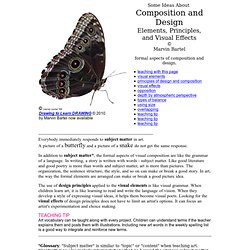
A picture of a butterfly and a picture of a snake do not get the same response. In addition to subject matter*, the formal aspects of visual composition are like the grammar of a language. In writing, a story is written with words - subject matter. Like good literature and good poetry is more than words and subject matter, art is more than pictures. The organization, the sentence structure, the style, and so on can make or break a good story. Section 1 Class 1 - Elements of Design Example and Gallery. Page 8 of 8Example & Student Gallery Description: 17 x 22 inch full color brochure for a local dining and entertainment center Chosen for: Mass.
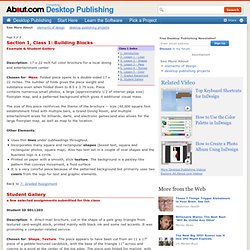
Folded piece opens to a double-sided 17 x 22 inches. The number of folds gives the piece weight and substance even when folded down to 8.5 x 3.75 size. Piece contains numerous small photos, a large (approximately 1/2 of interior page size) floorplan map, and a patterned background which gives it additional visual mass. The size of this piece reinforces the theme of the brochure -- size (40,000 square foot establishment filled with multiple bars, a Grand Dining Room, and multiple entertainment areas for billiards, darts, and electronic games)and also allows for the large floorplan map, as well as map to the location. Arts for Critical Thinking. The Art of Redesigning Instruction. Synthesis: Mastering the MovesThat Put the Parts of Reasoning Together.

The Incredible Art Department. Art Teacher Toolbox: Art Curriculum. Bloom's Taxonomy of Learning Domains. A Taxonomy of Reflection: Critical Thinking For Students, Teachers, and Principals (Part I) My approach to staff development (and teaching) borrows from the thinking of Donald Finkel who believed that teaching should be thought of as "providing experience, provoking reflection.

" He goes on to write, ... to reflectively experience is to make connections within the details of the work of the problem, to see it through the lens of abstraction or theory, to generate one's own questions about it, to take more active and conscious control over understanding. ~ From Teaching With Your Mouth Shut Over the last few years I've led many teachers and administrators on classroom walkthroughs designed to foster a collegial conversation about teaching and learning. The walkthroughs served as roving Socratic seminars and a catalyst for reflection. But reflection can be a challenging endeavor. In an effort to help schools become more reflective learning environments, I've developed this "Taxonomy of Reflection.
" - modeled on Bloom's approach. The Best Resources For Helping Teachers Use Bloom’s Taxonomy In The Classroom. Bloom’s & SOLO ‘are not Just Colorful Posters we Hang on the Wall’ is my two-part series at Education Week Teacher.

Bloom’s Taxonomy is talked about a lot in educational circles. However, if you believe a recent survey of visits to 23,000 U.S. classrooms, the higher-order thinking skills it’s ideally designed to promote doesn’t get much use. Developing Questions for Critical Thinking. “Education must be increasingly concerned about the fullest development of all children and youth, and it will be the responsibility of the schools to seek learning conditions which will enable each individual to reach the highest level of learning possible.”
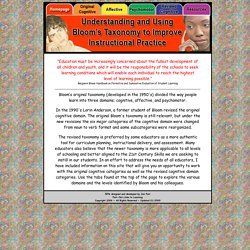
Benjamin Bloom Handbook on Formative and Summative Evaluation of Student Learning Bloom’s original taxonomy (developed in the 1950's) divided the way people learn into three domains: cognitive, affective, and psychomotor. In the 1990's Lorin Anderson, a former student of Bloom revised the original cognitive domain. Elements of Critical Thinking. Mycoted. At Learning Theories. Multiple Intelligences by Dr. Thomas Armstrong. Multiple Intelligences The theory of multiple intelligences was developed in 1983 by Dr.
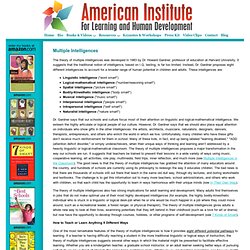
Howard Gardner, professor of education at Harvard University. It suggests that the traditional notion of intelligence, based on I.Q. testing, is far too limited. Instead, Dr. Gardner proposes eight different intelligences to account for a broader range of human potential in children and adults. Linguistic intelligence ("word smart") Logical-mathematical intelligence ("number/reasoning smart") Spatial intelligence ("picture smart") Bodily-Kinesthetic intelligence ("body smart") Musical intelligence ("music smart") Interpersonal intelligence ("people smart") Intrapersonal intelligence ("self smart") Naturalist intelligence ("nature smart") Dr.
ARCS Model of Motivational Design (Keller) at Learning Theories. Motivation Design. MyWGU Student Portal. MSN.com by HP Notebook. Teaching Tolerance. CharacterEd.Net - Home. Character Education Partnership. Center for Civic Education Home. Gay, Lesbian and Straight Education Network: Home. Welcome to the Main Page - workhelp. MinuteBio. Using Gagne's 9 Events of Learning in e-Learning. Why Six Sigma Projects Often Fail. Management Advice, News and Opinion. The Wall Street Journal: Over 60% of Improvement Projects Fail! In the Wall Street Journal this morning in an article written by Dr.
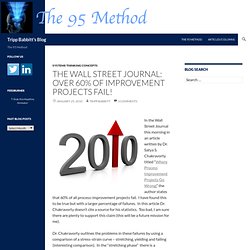
Satya S. Chakravorty titled “Where Process Improvement Projects Go Wrong,” the author states that 60% of all process-improvement projects fail. I have found this to be true but with a larger percentage of failures. In this article Dr.